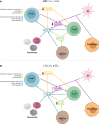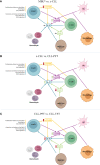Unravelling soluble immune checkpoints in chronic lymphocytic leukemia: Physiological immunomodulators or immune dysfunction
- PMID: 36248816
- PMCID: PMC9554405
- DOI: 10.3389/fimmu.2022.965905
Unravelling soluble immune checkpoints in chronic lymphocytic leukemia: Physiological immunomodulators or immune dysfunction
Abstract
Chronic lymphocytic leukemia (CLL) is a lymphoid neoplasm characterized by the accumulation of mature B cells. The diagnosis is established by the detection of monoclonal B lymphocytes in peripheral blood, even in early stages [monoclonal B-cell lymphocytosis (MBLhi)], and its clinical course is highly heterogeneous. In fact, there are well-characterized multiple prognostic factors that are also related to the observed genetic heterogenicity, such as immunoglobulin heavy chain variable region (IGHV) mutational status, del17p, and TP53 mutations, among others. Moreover, a dysregulation of the immune system (innate and adaptive immunity) has been observed in CLL patients, with strong impact on immune surveillance and consequently on the onset, evolution, and therapy response. In addition, the tumor microenvironment is highly complex and heterogeneous (i.e., matrix, fibroblast, endothelial cells, and immune cells), playing a critical role in the evolution of CLL. In this study, a quantitative profile of 103 proteins (cytokines, chemokines, growth/regulatory factors, immune checkpoints, and soluble receptors) in 67 serum samples (57 CLL and 10 MBLhi) has been systematically evaluated. Also, differential profiles of soluble immune factors that discriminate between MBLhi and CLL (sCD47, sCD27, sTIMD-4, sIL-2R, and sULBP-1), disease progression (sCD48, sCD27, sArginase-1, sLAG-3, IL-4, and sIL-2R), or among profiles correlated with other prognostic factors, such as IGHV mutational status (CXCL11/I-TAC, CXCL10/IP-10, sHEVM, and sLAG-3), were deciphered. These results pave the way to explore the role of soluble immune checkpoints as a promising source of biomarkers in CLL, to provide novel insights into the immune suppression process and/or dysfunction, mostly on T cells, in combination with cellular balance disruption and microenvironment polarization leading to tumor escape.
Keywords: cellular microenvironment; chronic lymphocytic leukaemia (CLL); cytokines profiles; immune dysfunction; soluble immune checkpoints.
Copyright © 2022 Landeira-Viñuela, Arias-Hidalgo, Juanes-Velasco, Alcoceba, Navarro-Bailón, Pedreira, Lecrevisse, Díaz-Muñoz, Sánchez-Santos, Hernández, García-Vaquero, Góngora, De Las Rivas, González, Orfao and Fuentes.
Conflict of interest statement
The authors declare that the research was conducted in the absence of any commercial or financial relationships that could be construed as a potential conflict of interest.
Figures








Similar articles
-
Chronic lymphocytic leukemia-like monoclonal B-cell lymphocytosis exhibits an increased inflammatory signature that is reduced in early-stage chronic lymphocytic leukemia.Exp Hematol. 2021 Mar;95:68-80. doi: 10.1016/j.exphem.2020.12.007. Epub 2021 Jan 7. Exp Hematol. 2021. PMID: 33421548 Free PMC article.
-
Combined patterns of IGHV repertoire and cytogenetic/molecular alterations in monoclonal B lymphocytosis versus chronic lymphocytic leukemia.PLoS One. 2013 Jul 3;8(7):e67751. doi: 10.1371/journal.pone.0067751. Print 2013. PLoS One. 2013. PMID: 23844084 Free PMC article.
-
Monoclonal B-cell lymphocytosis and chronic lymphocytic leukemia.N Engl J Med. 2008 Aug 7;359(6):575-83. doi: 10.1056/NEJMoa075290. N Engl J Med. 2008. PMID: 18687638
-
Pathology consultation on evaluating prognosis in incidental monoclonal lymphocytosis and chronic lymphocytic leukemia.Am J Clin Pathol. 2013 Jun;139(6):708-12. doi: 10.1309/AJCPLIR4GZWX3XKA. Am J Clin Pathol. 2013. PMID: 23690112 Review.
-
What does it mean I have a monoclonal B-cell lymphocytosis?: Recent insights and new challenges.Semin Oncol. 2016 Apr;43(2):201-8. doi: 10.1053/j.seminoncol.2016.02.013. Epub 2016 Feb 6. Semin Oncol. 2016. PMID: 27040697 Review.
Cited by
-
Systematic Evaluation of Antigenic Stimulation in Chronic Lymphocytic Leukemia: Humoral Immunity as Biomarkers for Disease Evolution.Cancers (Basel). 2023 Jan 31;15(3):891. doi: 10.3390/cancers15030891. Cancers (Basel). 2023. PMID: 36765855 Free PMC article.
-
Apoliprotein E-mediated ferroptosis controls cellular proliferation in chronic lymphocytic leukemia.Leukemia. 2025 Jan;39(1):122-133. doi: 10.1038/s41375-024-02442-0. Epub 2024 Oct 23. Leukemia. 2025. PMID: 39443737 Free PMC article.
-
Unlocking protein-based biomarker potential for graft-versus-host disease following allogenic hematopoietic stem cell transplants.Front Immunol. 2024 Feb 16;15:1327035. doi: 10.3389/fimmu.2024.1327035. eCollection 2024. Front Immunol. 2024. PMID: 38433830 Free PMC article. Review.
-
Programmed Death 1 and Cytotoxic T-Lymphocyte-Associated Protein 4 Gene Expression in Peripheral Blood Mononuclear Cells Can Serve as Prognostic Biomarkers for Hepatocellular Carcinoma.Cancers (Basel). 2024 Apr 13;16(8):1493. doi: 10.3390/cancers16081493. Cancers (Basel). 2024. PMID: 38672574 Free PMC article.
-
Physiological and Pathophysiological Roles of IgM Fc Receptor (FcµR) Isoforms.Int J Mol Sci. 2023 Mar 17;24(6):5728. doi: 10.3390/ijms24065728. Int J Mol Sci. 2023. PMID: 36982860 Free PMC article. Review.
References
-
- Awan FT, Byrd JC. 99 - chronic lymphocytic leukemia. In: Niederhuber JE, Armitage JO, Kastan MB, Doroshow JH, Tepper JE, editors. Abeloff’s clinical oncology, Sixth Edition. Philadelphia: Elsevier; (2020). p. 1850–1871.e5. doi: 10.1016/B978-0-323-47674-4.00099-2 - DOI
Publication types
MeSH terms
Substances
LinkOut - more resources
Full Text Sources
Research Materials
Miscellaneous

